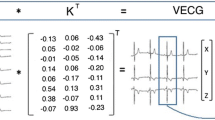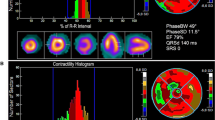Abstract
Purpose This investigation sought to determine which newly available asynchrony parameter derived from gated myocardial perfusion SPECT (GMPS) systolic wall thickening data best distinguishes patients with left bundle branch block (LBBB) from normal subjects. Methods and materials Emory Cardiac Toolbox (ECTb) algorithms were used to compute left ventricular (LV) global and regional function and perfusion indices with regional contraction phases for 20 patients with LBBB, and in 9 control (CTL) subjects who had no function or perfusion abnormalities. Histogram plots of phase frequencies versus R–R interval times included phase standard deviation (SD), bandwidth (BW), skewness and kurtosis. Z-score asynchrony measures were derived for phases sampled using the conventional 17-segment model. Results In CTLs contraction occurred nearly simultaneously in all segments, while LBBBs exhibited a wide variety of heterogeneous contraction patterns. Global parameters that differed between LBBBs versus CTLs included EF, end-systolic volume and end-diastolic volume, and asynchrony measures that were different included BW, phase SD and z-scores. Z-scores most strongly discriminated LBBBs from CTLs (93% of cases correctly predicted, logistic regression χ2 = 29.7, P < 0.0001). Z-scores, phase SD and lateral–septal wall timing were highly reproducible (r = 0.99, 0.99 and r = 0.87, respectively), with no significant inter-observer differences. Conclusion While traditional global function parameters were different in LBBBs and CTLs, asynchrony parameters characterized LBBB most strongly.




Similar content being viewed by others
Abbreviations
- BW:
-
Bandwidth
- CABG:
-
Coronary artery bypass graft
- CAD:
-
Coronary artery disease
- CTL:
-
Control subject
- CHF:
-
Congestive heart failure
- CRT:
-
Cardiac resynchronization therapy
- EDV:
-
End-diastolic volume
- ESV:
-
End-systolic volume
- EF:
-
Ejection fraction
- GMPS:
-
Gated myocardial perfusion SPECT
- LBBB:
-
Left bundle branch block
- LV:
-
Left ventricular
- MI:
-
Myocardial infarction
- ms:
-
Millisecond
- SSS:
-
Summed stress score
- SWT:
-
Systolic wall thickening
References
Jeong JH, Kim JH, Park YH et al (2004) Incidence of and risk factors for bundle branch block in adults older than 40 years. Korean J Intern Med 19:171–178
Cleland JG, Daubert JC, Erdmann E et al (2005) Cardiac Resynchronization-Heart Failure (CARE-HF) study investigators. The effect of cardiac resynchronization on morbidity and mortality in heart failure. N Engl J Med 352:1539–1549. doi:10.1056/NEJMoa050496
Gregoratos G, Abrams J, Epstein AE et al (2002) ACC/AHA/NASPE (2002) guideline update for implantation of cardiac pacemakers and antiarrhythmia devices a report of the American College of Cardiology/American Heart Association Task Force on Practice Guidelines (ACC/AHA/NASPE Committee on Pacemaker Implantation). Circulation 106:2145–2161. doi:10.1161/01.CIR.0000035996.46455.09
Leclercq C, Kass DA (2002) Retiming the failing heart: principles and current clinical status of cardiac resynchronization. J Am Coll Cardiol 39:194–201. doi:10.1016/S0735-1097(01)01747-8
Yu CM, Chau E, Sanderson JE et al (2002) Tissue Doppler echocardiographic evidence of reverse remodeling and improved synchronicity by simultaneously delaying regional contraction after biventricular pacing therapy in heart failure. Circulation 105:438–445. doi:10.1161/hc0402.102623
Candell-Riera J, Oller-Martínez G, Pereztol-Valdes O et al (2003) Usefulness of myocardial perfusion SPECT in patients with left bundle branch block and previous myocardial infarction. Heart 89:1039–1042. doi:10.1136/heart.89.9.1039
Tsurugaya H, Tada H, Toyama T et al (2004) Usefulness of quantitative gated single-photon emission computed tomography to evaluate ventricular synchrony in patients receiving biventricular pacing. Am J Cardiol 94:127–130. doi:10.1016/j.amjcard.2004.03.044
Chen J, Garcia EV, Folks RD et al (2005) Onset of left ventricular mechanical contraction as determined by phase analysis of ECG-gated myocardial perfusion SPECT imaging: development of a diagnostic tool for assessment of cardiac mechanical dysynchrony. J Nucl Cardiol 12:687–695. doi:10.1016/j.nuclcard.2005.06.088
Trimble MA, Borges-Neto S, Smallheiser S et al (2007) Evaluation of left ventricular mechanical dyssynchrony as determined by phase analysis of ECG-gated SPECT myocardial perfusion imaging in patients with left ventricular dysfunction and conduction disturbances. J Nucl Cardiol 14(3):298–307. doi:10.1016/j.nuclcard.2007.01.041
Faber TL, Cooke CD, Folks RD et al (1999) Left ventricular function and perfusion from gated SPECT perfusion images: an integrated method. J Nucl Med 40:650–659
Hachamovitch R, Berman DS, Kiat H et al (1996) Exercise myocardial perfusion SPECT in patients without known coronary artery disease: incremental prognostic value and use in risk stratification. Circulation 93:905–914
Galt JR, Garcia EV, Robbins WL (1990) Effects of myocardial wall thickness on SPECT quantification. IEEE Trans Med Imaging 9:144–150. doi:10.1109/42.56338
Cerqueira MD, Weissman NJ, Dilsizian V et al (2002) Standardized myocardial segmentation and nomenclature for tomographic imaging of the heart. A statement for healthcare professionals from the Cardiac Imaging Committee of the Council on Clinical Cardiology of the American Heart Association. Int J Cardiovasc Imaging 18:539–542
Vilain D, Daou D, Casset-Senon D, Faraggi M, Le Guludec D (2001) Optimal 3-dimensional method for right and left ventricular Fourier phase analysis in electrocardiography-gated blood-pool SPECT. J Nucl Cardiol 8:371–378. doi:10.1067/mnc.2001.114151
Trimble MA, Velazquez EJ, Adams GL et al (2008) Repeatability and reproducibility of phase analysis of gated single-photon emission computed tomography myocardial perfusion imaging used to quantify cardiac dyssynchrony. Nucl Med Commun 29(4):374–381
Nichols KJ, Van Tosh A, De Bondt P et al (2008) Normal limits of gated blood pool SPECT count-based regional cardiac function parameters. Int J Cardiovasc Imaging. http://www.springerlink.com/content/1569–5794
Nichols K, Santana CA, Folks R et al (2002) Comparison between “ECTb” and “QGS” for assessment of left ventricular function from gated myocardial perfusion SPECT. J Nucl Cardiol 9:285–293. doi:10.1067/mnc.2002.121449
Yu CM, Chan YS, Zhang Q et al (2006) Benefits of cardiac resynchronization therapy for heart failure patients with narrow QRS complexes and coexisting systolic asynchrony by echocardiography. J Am Coll Cardiol 48(11):2251–2257. doi:10.1016/j.jacc.2006.07.054
Yu CM, Fung JW, Zhang Q et al (2004) Tissue Doppler imaging is superior to strain rate imaging and postsystolic shortening on the prediction of reverse remodeling in both ischemic and nonischemic heart failure after cardiac resynchronization therapy. Circulation 110(1):66–73. doi:10.1161/01.CIR.0000133276.45198.A5
Johnson LL, Verdesca SA, Aude WY et al (1997) Postischemic stunning can affect left ventricular ejection fraction and regional wall motion on post-stress gated sestamibi tomograms. J Am Coll Cardiol 30(7):1641–1648. doi:10.1016/S0735-1097(97)00388-4
Alonso C, Leclercq C, Victor F et al (1999) Electrocardiographic predictive factors of long-term clinical improvement with multisite biventricular pacing in advanced heart failure. Am J Cardiol 84:1417–1421. doi:10.1016/S0002-9149(99)00588-3
Henneman MM, Chen J, Dibbets-Schneider P et al (2007) Can LV dyssynchrony as assessed with phase analysis on gated myocardial perfusion SPECT predict response to CRT? J Nucl Med 48:1104–1111. doi:10.2967/jnumed.107.039925
Chen J, Henneman MM, Trimble MA et al (2008) Assessment of left ventricular mechanical dyssynchrony by phase analysis of ECG-gated SPECT myocardial perfusion imaging. J Nucl Cardiol 15:127–136. doi:10.1016/j.nuclcard.2007.11.004
Acknowledgements
We would like to thank Jing Han for her expert assistance with the statistical analysis reported for this project. This work was supported by a grant from the Saint Francis Research Foundation. Some of the authors (Chen, Garcia) receive royalties from the sale of Phase Analysis tool with the Emory Cardiac Toolbox.
Author information
Authors and Affiliations
Corresponding author
Rights and permissions
About this article
Cite this article
Nichols, K.J., Van Tosh, A., Siddiqi, S. et al. Gated myocardial perfusion SPECT asynchrony measurements in patients with left bundle branch block. Int J Cardiovasc Imaging 25, 43–51 (2009). https://doi.org/10.1007/s10554-008-9354-9
Received:
Accepted:
Published:
Issue Date:
DOI: https://doi.org/10.1007/s10554-008-9354-9




